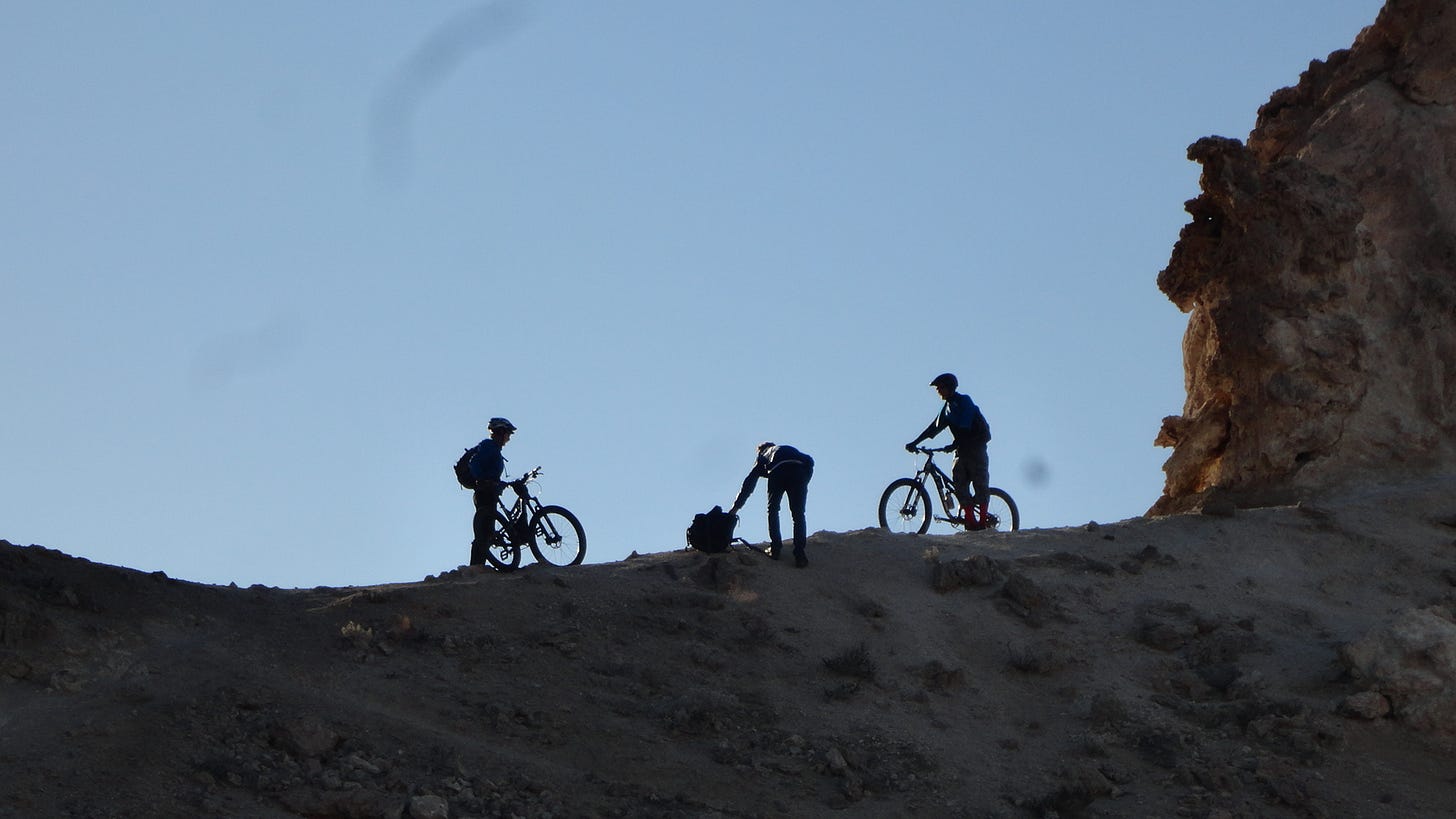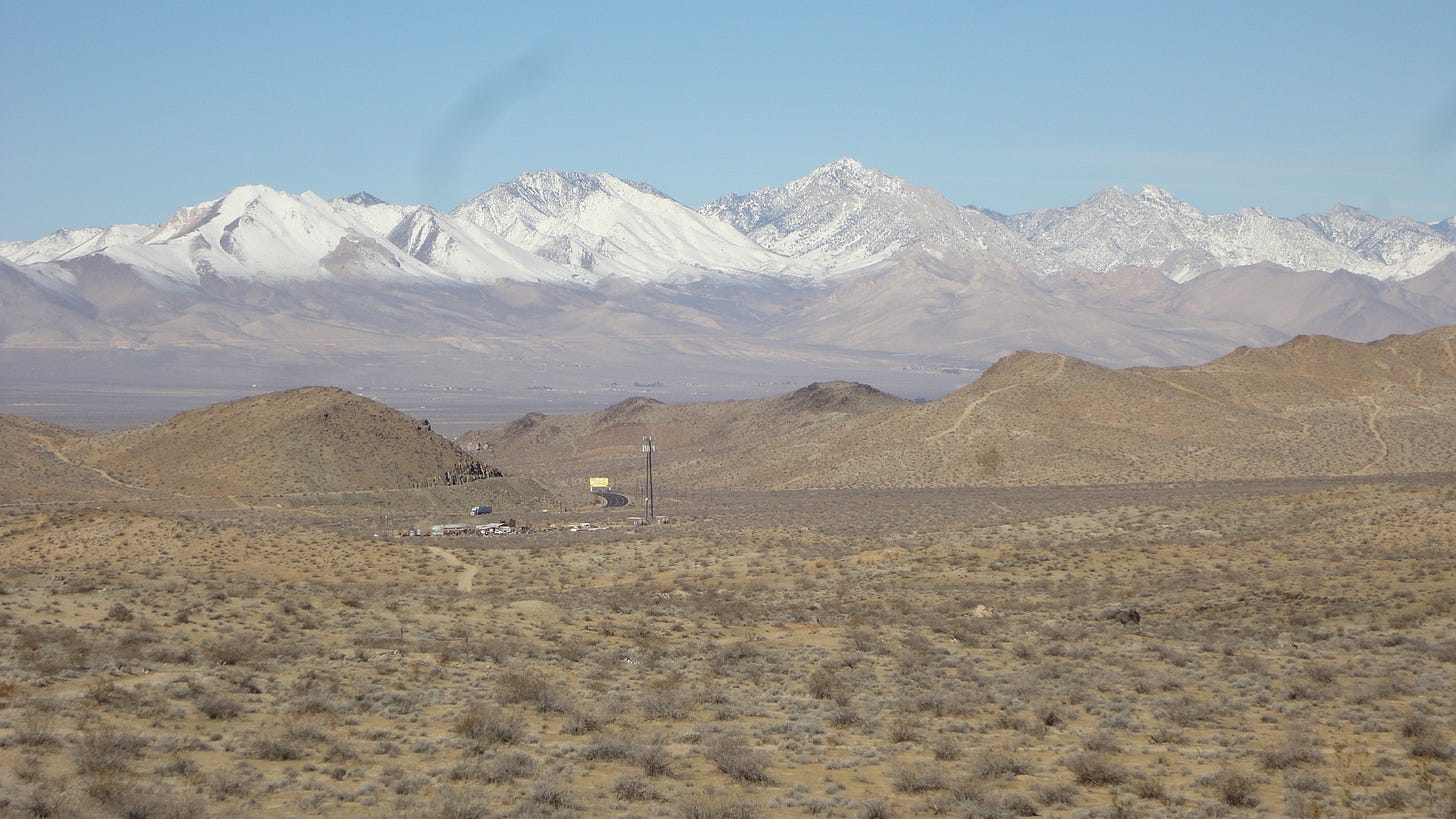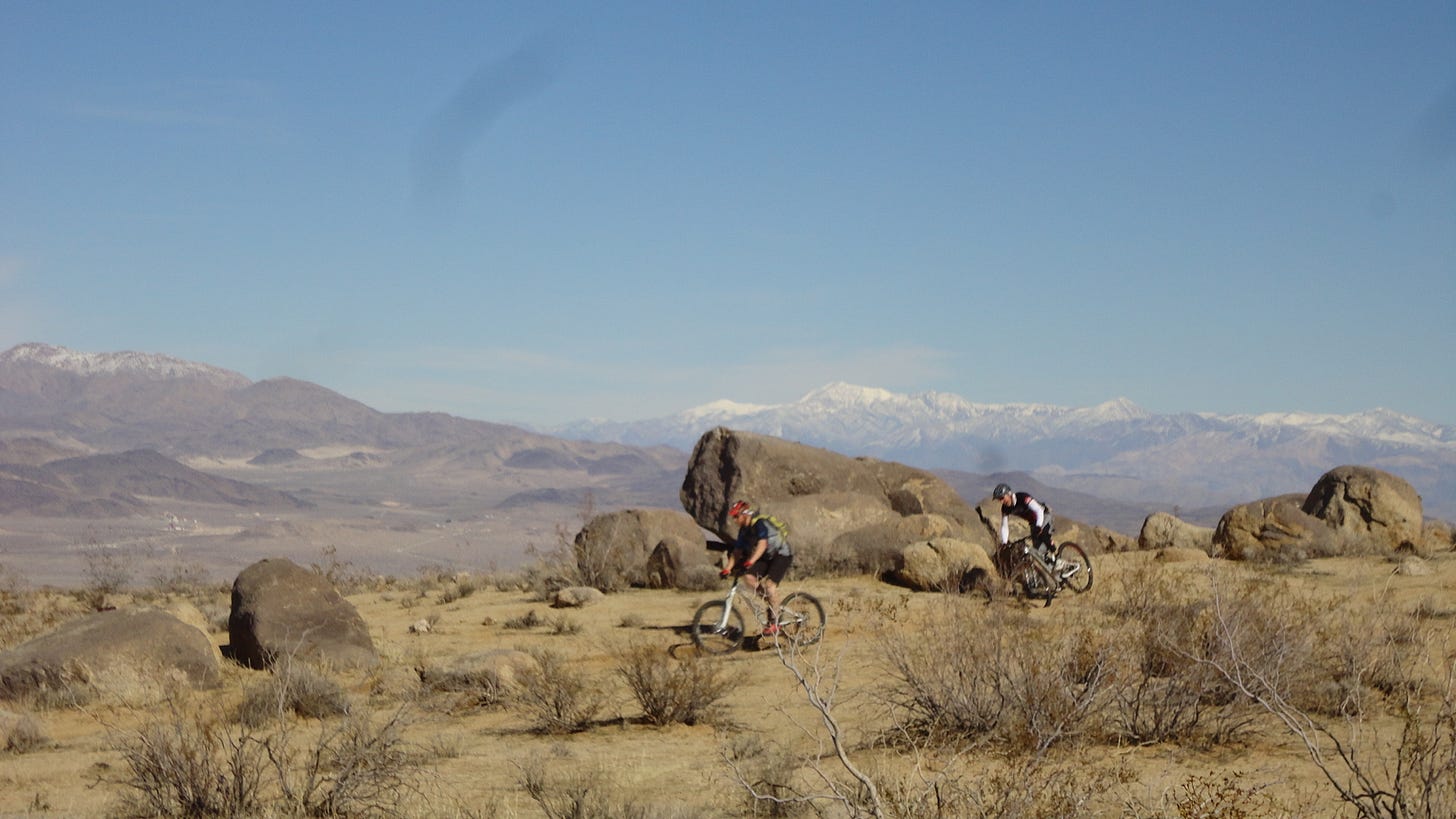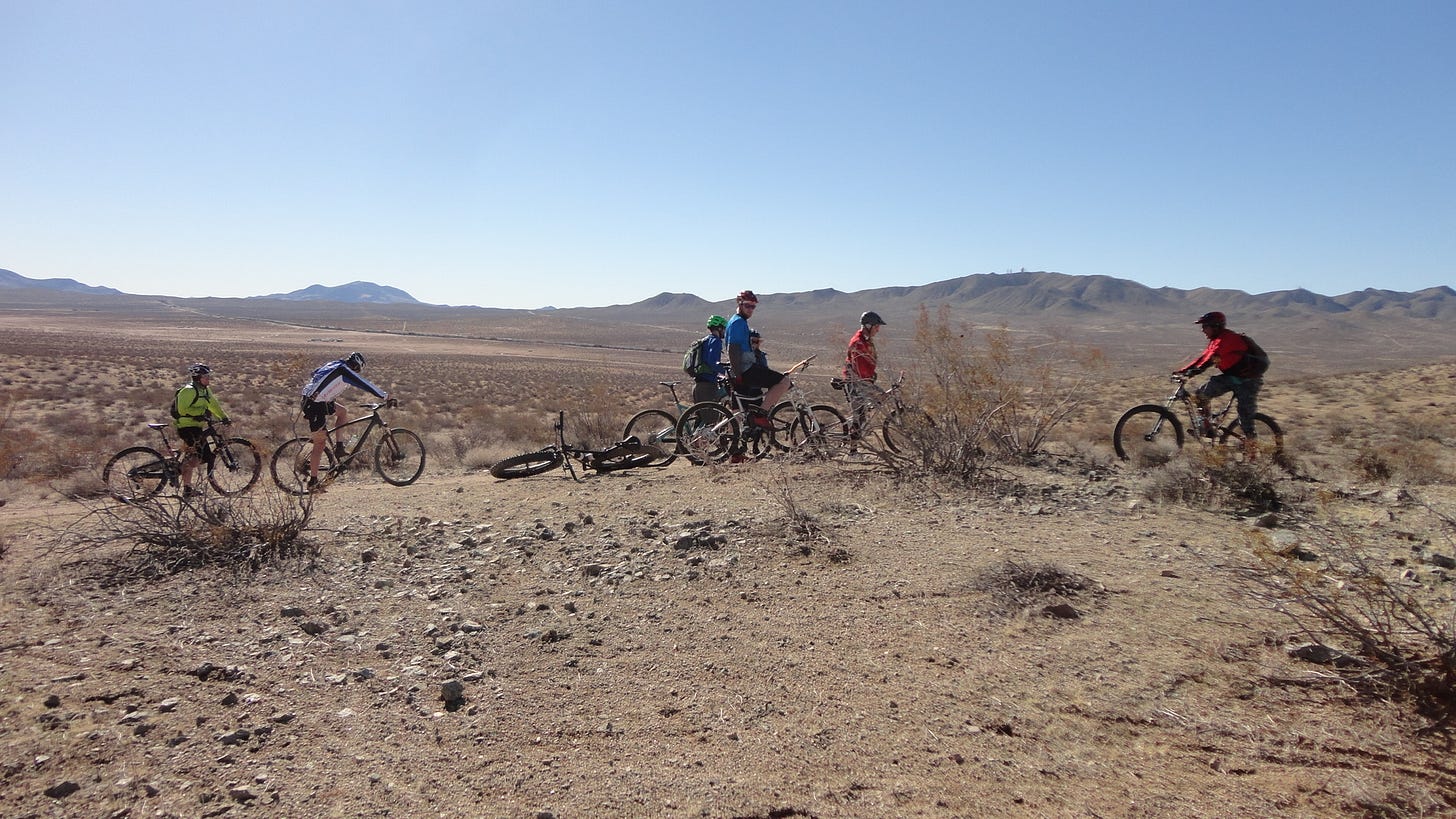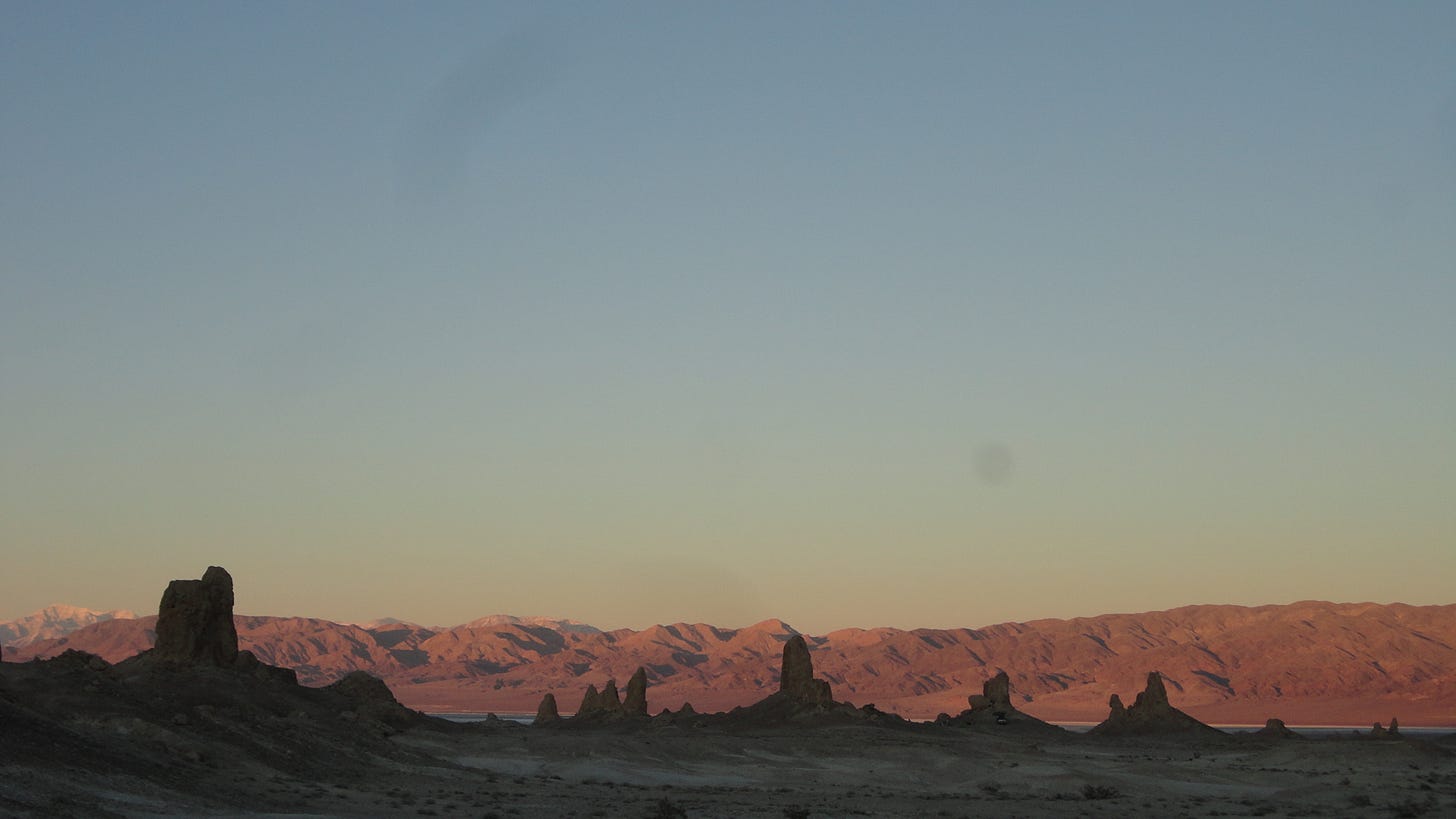Back in 2017, Bike Magazine, which is dead but has morphed into Beta, sent me and a photographer, to capture the riding/trails in the High Mojave area around Ridgecrest. Twenty years ago I lived there, happening upon desert riding with 1.95 tires (!). It’s a region of space and time, an intersection or coming together of the Eastern Sierra and high desert that is one of my favorite places to pass days and nights.
The article is here …
High Mojave MTB: Ridgecrest and the Trona Pinnacles
“East away from the Sierras, south from Panamint and Amargosa, east and south many an uncounted mile, is the Country of Lost Borders.” --The Land of Little Rain, Mary Austin
Seventeen years ago, I chased love across the USA from the forested green hills of Pennsylvania to the desert tortoise brown corrugated tapestry of the High Mojave, pulling into Ridgecrest, CA as the sun set on the southern Sierra Nevada. Human love happened and grew stronger, thriving still today. Unknowing to me, I ended up having a love affair with the open sky and land of the high desert too: austere, piercing light, calming sunrises, spectacular sunsets, snow-capped mountains, intense heat, creosote and Joshua Trees, and the winds, my goodness the winds.
Memories of mountain biking in such a setting bedded deep in my bones over the years since then, patiently waiting to wake. With new friends on board for a road trip and plans to meet up with local riders, the memories started to stir. Winter riding after abundant rains down low and heavy snow up top made for perfect riding conditions. The trails were packed down, meaning not deep sand, and the view scape of nearly 360-degree snowy mountains was more than a dream could ever conjure up in the mind space.
Friday afternoon, we arrived to the Trona Pinnacles, the often-called “other-worldly” natural wonder that sits twenty miles east of Ridgecrest on the way to Death Valley. Is it what it would be like riding on the moon? Mars?
We quickly set up camp and then began exploring the single tracks spider-webbing around the Pinnacles. Paying close attention to the words on the Bureau of Land Management (BLM) website, we stayed on “established routes” as we wandered with no destination, mountain biking being permitted in the National Natural Landmark. Dusk came sooner than we wanted, our time waning while pedaling some of the 14-square mile expanse of calcium carbonate spires, a.k.a. tufa, that formed between 10,000 and 100,000 years ago.
Back at camp, we cooked food in a natural bowl surrounded by Pinnacles that we called sentinels; we sat by the campfire, drank beers, and watched the night sky turn starry, the Milky Way shining bright. Crawling into our tents, the sentinels stood guard over us.
Dawn broke cold. We shivered while cooking oatmeal, drinking coffee and tea, and shimmying into riding clothes, with a 9:00 AM meet up time pepping our step. The day’s agenda was set by the High Sierra Cyclists (HSC), the local Ridgecrest club we were to meet at the parking lot behind Cerro Coso Community College, the same one I parked at back in 2000-01 when I lived in town. A little late, we showed up and found a cheery and super friendly group, eager to show us around the Rademacher Hills, a 500+ acre BLM-managed area where 19th century miners and prospectors cut trails and set up shop for a while, digging for their own dreams.
To get the blood moving, we set out on a fast pace to ride the current Ridgecrest Desert Classic pro race loop, but for the locals, it was a warm-up crank mixing between double track and single track as we went. Interjection: Make no bones about it, if you think you are speedy, ride with Doug, Colby, and Will. If you keep up with them, yes, you are fast.
“That’s where the beginners turn back. It’s the Desert Classic.”
From 1990-99, the legendary Ridgecrest Desert Classic (RDC) was attended by many racers, bringing in elite pros. In 2016, five years after HSC revived the race, Tinker showed up and blitzed the 27 mile pro/expert loop in under two hours.
We did not turn back at the intersection for the classic loop; the 27 miler was on the day’s slate. Needless to say, two hours was nothing we non-locals could manage. Cross-country riding characterized the terrain, up and down and up and down we went, continuing the mixed riding of single and double track as we made our way to the Fun House.
“I don’t think the Fun House is all that fun,” said Doug, matter-of-factly. I thought for sure Doug’s riding style—pure masher—was that of a single speeder, but it was not, he said. Hmm?
Six miles of tight and twisting single track through fields of boulders was the Fun House, a slow gradual, circuitous ascent followed by a flow-like descent of the same nature. With the long-view of Death Valley’s Telescope Peak covered in snow, the Fun House was a scenic pedal-fest, sometimes a bit of a grind and other times a big smiley face ride.
Said Matt, one of the HSC organizers of the current RDC, “The pros and experts come back and talk about how much they love the Fun House.”
Matt added as we neared the end of the Fun House, prior to the Devil’s Backbone, “After the second part of the climb, there is more climbing along the backbone. There’s a theme here.” He then smiled and grinned at the same time, not quite sinister.
Here’s the lesson, I thought: Yin Yang. The Fun House was the pre-cursor to the Devil’s Backbone, a fairly long climb up to the Ridgeline trail that, late in the ride, tests your mettle.
Nevertheless, up on the ridge, the trail turned rocky, and here and there it was a little precipitous, putting the “mountain” in MTB. Again, vistas of the snowcapped Sierra Nevada and Panamint Range abounded, all the while riding high-and-dry in the sunshine, making for idyllic pedaling, though much wasn’t needed as we went down, down, down.
At one regroup spot, I thought of Mary Austin’s American classic:
“There are hills, rounded, blunt, burned, squeezed up out of chaos, chrome and vermillion painted, aspiring to the snow-line.” --The Land of Little Rain
Later in the evening, back at the Pinnacles where we had more beer and more campfire staring, along with carne asada tacos and cheese-stuffed peppers cooked on the fire, we summarized the day as a big 27 miles, bigger than a lot of other miles. Our camp friend, a desert fox, made an appearance for the second night in a row. The stars shone bright above, a majestic roof on our world where the sentinels stood tall in the surrounding darkness, save for the star and camp fire light.
In the morning, we woke to warmer air and with another plan to meet the High Sierra Cyclists for a few more hours of riding. Driving back over to the trailhead, Mary Austin visited me one more time. The High Mojave on the other side of the windshield reminded me that seventeen years later, it was still there, pretty much unchanged, looking the same. It was a landscape of “… treeless spaces [that] uncramp the soul.”
411
Camping: The Trona Pinnacles National Natural Landmark is on BLM land. It is free to camp. There is no water, only a pit toilet. Bring what you need, or buy it in Ridgecrest on the way through town. I highly recommend spending at least one night there. It is a 20 minute drive east on Route 178 from Ridgecrest to the turn off for the Pinnacles. The road back to the Pinnacles is 5 miles on dirt/desert. You don’t need 4WD.
Riding the High Mojave Trails:
At the Pinnacles, simply stay on “established routes,” as per the BLM website. Between desert two-track and segments of single track in the area, you could do anywhere from 10-20 miles of riding. Continue on further into the desert by simply following a track, and you could go on for a while. It is possible to traverse the desert to the Rademacher Hills in Ridgecrest.
Rademacher Hills in Ridgecrest is home to the 27 mile race loop. Possibilities for adding on more miles exist. It’s recommended to hook up with the local crew if it’s your first time riding there. See “Guides” below.
Plus sized tires would be good due to possible deep sand and the varied trail conditions. Trails and two-track could be hard-packed , sandy, or somewhere in between, all in the same mile, while up on the ridges they are rocky. Note: the locals also rode “skinny” 2.1 tires.
Lodging: If camping is not for you, there are plenty of hotel options available in Ridgecrest, ranging from cheap local motels to national motel and hotel brands.
Food: There’s a Barbacoa Texcoco style taco truck at the stop light/intersection/corner of 178 and Business 395/China Lake Boulevard in Ridgecrest. If it’s not there, look around town.
Kristy’s in Ridgecrest is a friendly, affordable diner with generous portions and serves up hearty breakfasts.
Bike shops: In Ridgecrest, there are two local businesses: TJ Frisbee Bicycles and Bob and Ardyce’s Bicycle Shop.
When to ride: the desert can get really hot as early as March, lasting possibly into late October. There’s no water out in the Rademacher Hills. November-February are usually cooler and possibly cold.
Guides: The High Sierra Cyclists are more than willing to meet up with you and show you around the local hills. Let them know your ability and they’ll match a ride for you:




